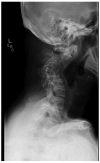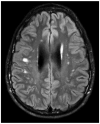Clinical manifestations, etiology, and pathogenesis of the hyper-IgE syndromes
- PMID: 19190525
- PMCID: PMC2919366
- DOI: 10.1203/PDR.0b013e31819dc8c5
Clinical manifestations, etiology, and pathogenesis of the hyper-IgE syndromes
Abstract
Autosomal dominant Hyper-IgE syndrome (AD-HIES) is a rare primary immunodeficiency characterized by eczema, recurrent skin and lung infections, elevated serum IgE, and various connective tissue, skeletal, and vascular abnormalities. Mutations in signal transducer and activator of transcription 3 (STAT3) have recently been found to account for most cases; however, the pathogenesis of the varied features remains poorly defined. A distinct syndrome, known as autosomal recessive HIES (AR-HIES) manifests as severe eczema, recurrent bacterial and viral skin infections, and sinopulmonary infections. As opposed to STAT3 deficient HIES, AR-HIES lacks the connective tissue and skeletal manifestations but has an increase in neurologic abnormalities. In this review, we discuss the clinical presentations, genetic etiologies, and immunologic abnormalities of these two syndromes. In addition, we discuss animal models of STAT3 deficiency that provide insight into the pathogenesis of HIES. Further understanding of how STAT3 results in the diverse manifestations of HIES will allow us to develop more specific therapies for HIES as well as for many of the manifestations, such as scoliosis, recurrent staphylococcal infections, and eczema, which are common in the general population.
Figures




Similar articles
-
Pathogenesis of hyper IgE syndrome.Clin Rev Allergy Immunol. 2010 Feb;38(1):32-8. doi: 10.1007/s12016-009-8134-1. Clin Rev Allergy Immunol. 2010. PMID: 19452285 Review.
-
[Hyper-IgE syndromes].Lin Chuang Er Bi Yan Hou Tou Jing Wai Ke Za Zhi. 2017 Jun 5;31(11):892-896. doi: 10.13201/j.issn.1001-1781.2017.11.019. Lin Chuang Er Bi Yan Hou Tou Jing Wai Ke Za Zhi. 2017. PMID: 29775011 Review. Chinese.
-
Hyper IgE syndrome: an update on clinical aspects and the role of signal transducer and activator of transcription 3.Curr Opin Allergy Clin Immunol. 2008 Dec;8(6):527-33. doi: 10.1097/ACI.0b013e3283184210. Curr Opin Allergy Clin Immunol. 2008. PMID: 18978467 Review.
-
An update on the hyper-IgE syndromes.Arthritis Res Ther. 2012 Nov 30;14(6):228. doi: 10.1186/ar4069. Arthritis Res Ther. 2012. PMID: 23210525 Free PMC article. Review.
-
Clinical manifestations of hyper IgE syndromes.Dis Markers. 2010;29(3-4):123-30. doi: 10.3233/DMA-2010-0734. Dis Markers. 2010. PMID: 21178271 Free PMC article. Review.
Cited by
-
Vaccination with a UV-irradiated genetically attenuated mutant of Staphylococcus aureus provides protection against subsequent systemic infection.J Infect Dis. 2012 Dec 1;206(11):1734-44. doi: 10.1093/infdis/jis579. Epub 2012 Sep 10. J Infect Dis. 2012. PMID: 22966130 Free PMC article.
-
Chronic mucocutaneous candidiasis and connective tissue disorder in humans with impaired JNK1-dependent responses to IL-17A/F and TGF-β.Sci Immunol. 2019 Nov 29;4(41):eaax7965. doi: 10.1126/sciimmunol.aax7965. Sci Immunol. 2019. PMID: 31784499 Free PMC article.
-
Ocular involvement in primary immunodeficiency diseases.J Clin Immunol. 2014 Jan;34(1):23-38. doi: 10.1007/s10875-013-9974-2. Epub 2013 Nov 30. J Clin Immunol. 2014. PMID: 24292697 Review.
-
Genetic interstitial lung disease.Clin Chest Med. 2012 Mar;33(1):95-110. doi: 10.1016/j.ccm.2011.11.001. Epub 2011 Dec 6. Clin Chest Med. 2012. PMID: 22365249 Free PMC article. Review.
-
IL-17: overview and role in oral immunity and microbiome.Oral Dis. 2017 Oct;23(7):854-865. doi: 10.1111/odi.12598. Epub 2016 Dec 27. Oral Dis. 2017. PMID: 27763707 Free PMC article. Review.
References
-
- Davis SD, Schaller J, Wedgwood RJ. Job’s syndrome. Recurrent, “cold” staphylococcal abscesses. Lancet. 1966;1:1013–1015. - PubMed
-
- Buckley RH, Wray BB, Belmaker EZ. Extreme hyperimmunoglobulinemia E and undue susceptibility to infection. Pediatrics. 1972;49:59–70. - PubMed
-
- Buckley RH. The hyper IgE syndrome. Clin Rev Allergy Immunol. 2001;20:139–154. - PubMed
-
- Grimbacher B, Holland SM, Gallin JI, Greenberg F, Hill SC, Malech HL, Miller JA, O’Connell AC, Puck JM. Hyper-IgE syndrome with recurrent infections-an autosomal dominant multisystem disorder. N Engl J Med. 1999;340:692–702. - PubMed
-
- Holland SM, DeLeo FR, Elloumi HZ, Hsu AP, Uzel G, Brodsky N, Freeman AF, Demidowich A, Davis J, Turner ML, Anderson VL, Darnell DN, Welch PA, Kuhns DB, Frucht DM, Malech HL, Gallin JI, Kobayashi SD, Whiteny AR, Voyich JM, Musser JM, Woellner C, Schaffer AA, Puck JM, Grimbacher B. STAT3 mutations in they hyper-IgE syndrome. N Engl J Med. 2007;357:1608–1619. - PubMed
Publication types
MeSH terms
Substances
Grants and funding
LinkOut - more resources
Full Text Sources
Research Materials
Miscellaneous

